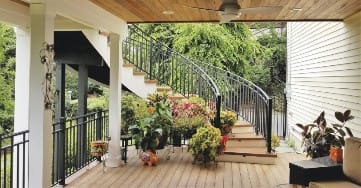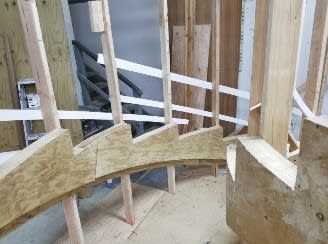phamENG
Structural
- Feb 6, 2015
- 7,626


This is not my project, just something I came across that looked both neat, but also a little concerning and I thought I'd post it here for a general discussion. The idea of a deck builder fabricating curved beams out of plywood in his shop and then installing them outside sets off alarm bells for me. APA has their "Supplement 5: Design and Fabrication of All-Plywood Beams," but they don't mention exterior exposure of the beam (just reference to adhesive exposure ratings).
How do others feel? Are you okay with is as long as the adhesive (both in the plywood and between lamination) is rated for exterior use with frequent/prolonged wetting AND the plies in the plywood have been preservative treated? Or is it more about using a moisture barrier on the top surface of the beam (between the tread and the stringer and the riser board and stringer, properly lapped) and the PVC trim on the side. I'd tend to be okay with the second in less humid environments, but here in the Mid-Atlantic and the South East (US) where you almost need gills to breathe I'd be worried.
If you're good with this kind of construction, how long do you think it would last if properly maintained? What kind of maintenance would you expect?
Link
PDF of the article (pop up trying to get you to sign up to their newsletter is really annoying):
